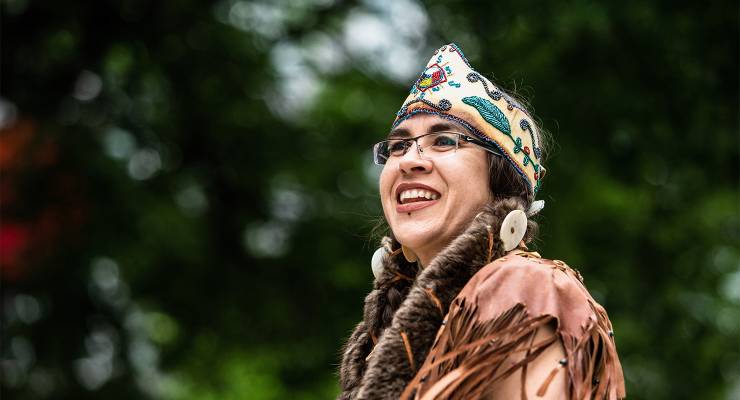
Imagine a country with over a dozen First Nations police forces. Where a self-government act can see First Nations peoples make decisions about land, people and resources. Where First Nations peoples can take the helm of their own healthcare.
If it seems too aspirational, go to Canada.
It’s a worthy case study: Aboriginal and Torres Strait Islander People make up a similar slice (3.3%) of the Australian population as First Nations people do (4.9%) in the Great White North. Both have experienced genocide, colonisation, exclusion, dispossession and assimilation at the hands of a Commonwealth government.
So, as NAIDOC Week 2022 comes to a close, why is Australia still a mere speck on the horizon behind Canada when it comes to First Nations recognition under the law?
The two nations diverged early in their white colonial history.
It’s 1763 and Britain has just forced France to forfeit its Canadian territory, but King George III knows the future of the British Empire relied upon good rapport with First Nations peoples. So he creates a document that changes Canada forever.
It draws land boundaries and lays out the rules for dealing with First Nations, but crucially it also makes any private land sales between First Nations and citizens null and void. Only the Crown can buy land, and only after a public consultation with a First Nation.
Sounding familiar? You guessed it: it was Canada’s first land rights title. It would take Australia nearly 200 years longer to establish our own — known as the Aboriginal Land Rights (Northern Territory) Act 1976.
Fast forward to 1817, and the Crown signs its first treaty with Canada’s First Nations. Dozens of treaties have been signed with the government since — several prior to Canada’s confederation that are still in play today, like the Treaties of Peace and Neutrality (1701-1760) and the Peace and Friendship Treaties (1725-1779).
Treaties — although at times broken — have seen the return of 600,000 square kilometres of land to First Nations peoples, capital transfers of $3.2 billion, and, perhaps most significantly, political recognition.
In 1982, Canada recognised First Nations peoples in the constitution — it affirmed and protected the treaty rights, meaning governments have to work with First Nations peoples when policies will affect them.
And yet Australian leaders talked about a Voice to Parliament with alarmist language as recently as Malcolm Turnbull’s prime ministership, deriding it as a “third chamber” of government — even though it’d have no power to initiate, pass or reject bills.
The language can feel different in Canada. Where Australia’s government said the Wangan and Jagalingou peoples’ opposition to the Adani mine was selfish, the chief executive of the Canadian Association for Mineral Exploration said Indigenous involvement brought “clarity and certainty for investment”.
Australia has not recognised Indigenous people in the constitution, and no treaty has ever been negotiated between an Aboriginal and/or Torres Strait Islander clan or nation and an Australian government at any level.
But it’s not without trying. Back in 1935, William Cooper, one of the founders of NAIDOC, petitioned King George V for Aboriginal electorates in our federal Parliament to place the power back in the hands of First Nations folks.
The Australian government rejected Cooper’s petition.
Writing for The Canberra Times today, Senator Lidia Thorpe, a proud DjabWurrung Gunnai Gunditjmara woman, says “our fight for justice doesn’t exist in a vacuum. Every day, all around the world, First Nations people are advocating for the rights of our communities and our country.”
“A Treaty, or Treaties, is a peace-making instrument,” she continues.
“It’s an end to the war and an opportunity to mature as a nation. To create a unified national identity that celebrates what unites us …
“It’s time to Treaty.”
And progress is afoot. In the last sitting week of the Senate, Thorpe introduced a Private Senators Bill to ensure this country complies with the United Nations Declaration on the Rights of Indigenous Peoples.
“When correctly implemented the UN declaration will stop state and federal governments from locking First Nations people out of decisions, cutting services, and driving inequality in the places where billions of dollars are being extracted by mining corporations,” she says.
If it sounds radical, think again. Canada’s First Nations peoples had the right to self-government enshrined into law in 1995. If a Voice to Parliament in Australia is walking, the right to self-government in Canada is sprinting — it gives them control of the administration of their people, land, resources and related programs and policies.
What does this mean? Take the Canadian Indian Health Transfer Policy in 1979. It said all 97 First Nations communities can take administrative control of health services if they think they need to.
But not everything is working and there’s still a lot of work to do. First Nations peoples in Canada make up 30% of the prison population (to Australia’s 28%) — more than six times the overall population.
Small pairs of shoes still line monuments in major Canadian cities to represent more than 1000 skeletons dug up outside residential schools — Indigenous children laid to rest without names in unmarked graves.
The story broke over a series of harrowing months, each new bone discovery across Canada a blow to the nation’s sense of self.
Canada’s contrition, however, feels markedly different.
This week Canada reached its largest-ever settlement — some A$22.5 billion — with its First Nations peoples over state-sanctioned discrimination that saw Indigenous kids make up half the foster-care population — more than seven times the country’s Indigenous child population.
The historic payout still needs to be approved by the Canadian Human Rights Tribunal (similar to our Australian Human Rights Commission) and the Federal Court, but will equate to $40,000 per affected child, the maximum amount of money possible allowed under the Canadian Human Rights Act.
So what would Australia look like if its laws better served this land’s First Nations peoples?
Put simply, Thorpe says, “a nation that reflects the values we all share so everyone can be treated equally and experience the same respect and dignity”.
“Whether we’ve been here for five years, five generations or five thousand generations, we need to work together and redesign things so it’s fair for everyone.”








Please note that the Australian political class and their billionaire masters are in a war with all Australians not just indiginous. So not much hope for a while.
A good example of how far Australia has to come is the risible caption:
“An Indigenous dancer in full traditional dress on National Indigenous Peoples Day in Montreal, Canada”
How about giving the person an actual name? If that’s too hard, how about at least naming their tribal and cultural affiliation and the type of “traditional dress” they are wearing and what it means?
Hi Bob, a valid point. However, the image was from our usual image provider (AAP), and there was no further information relating to the identity or traditional dress of the person photographed. But I agree that this information should always be stated when available.
Thanks,
Jack (Crikey production staff)
Well, that kind of reinforces my point about tokenism …
Much, much more has to be given to first nations people to decide what they see best suits their needs.
Consultation not we know best from (OTHERS).
The United States also had many treaties with the original inhabitants of the land. It broke every single one. So mayb
How does the general situation of indigenous Canadians compare to Australia’s?